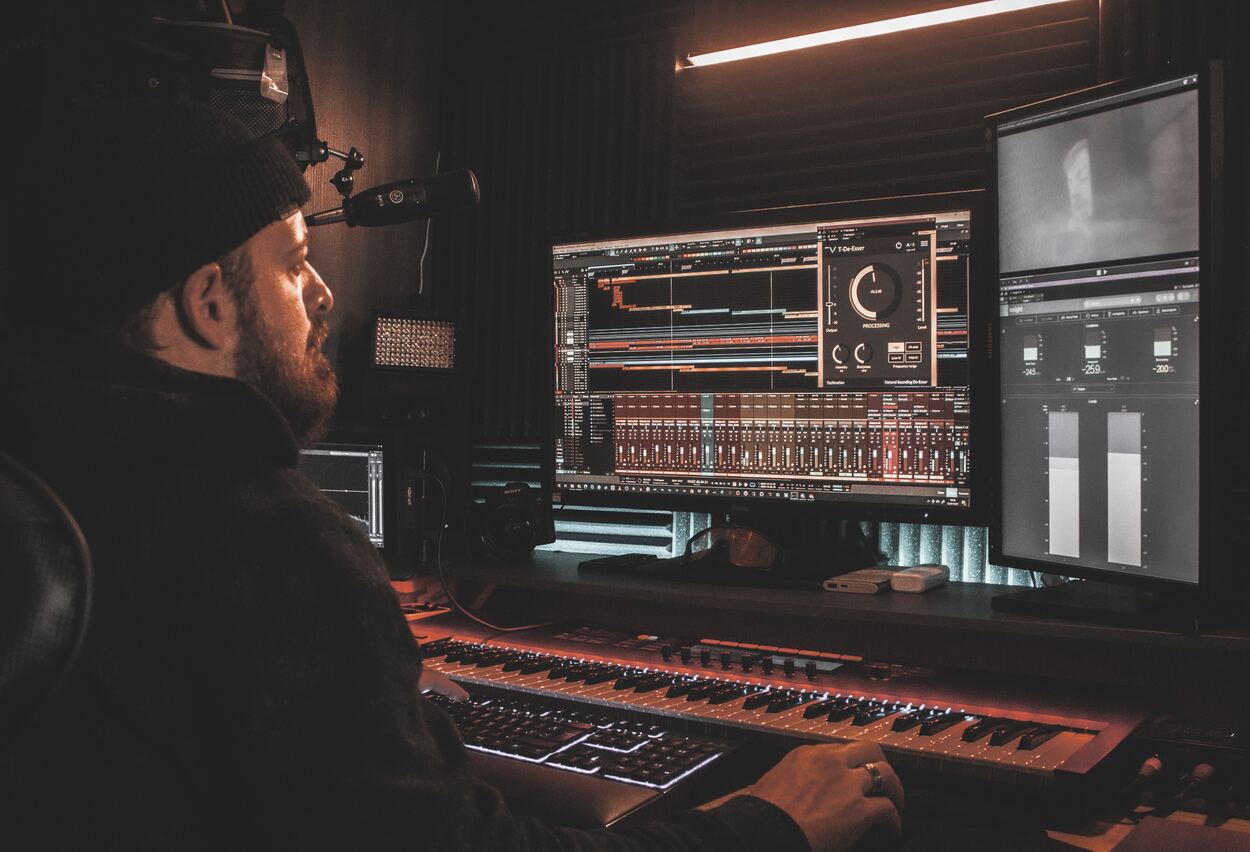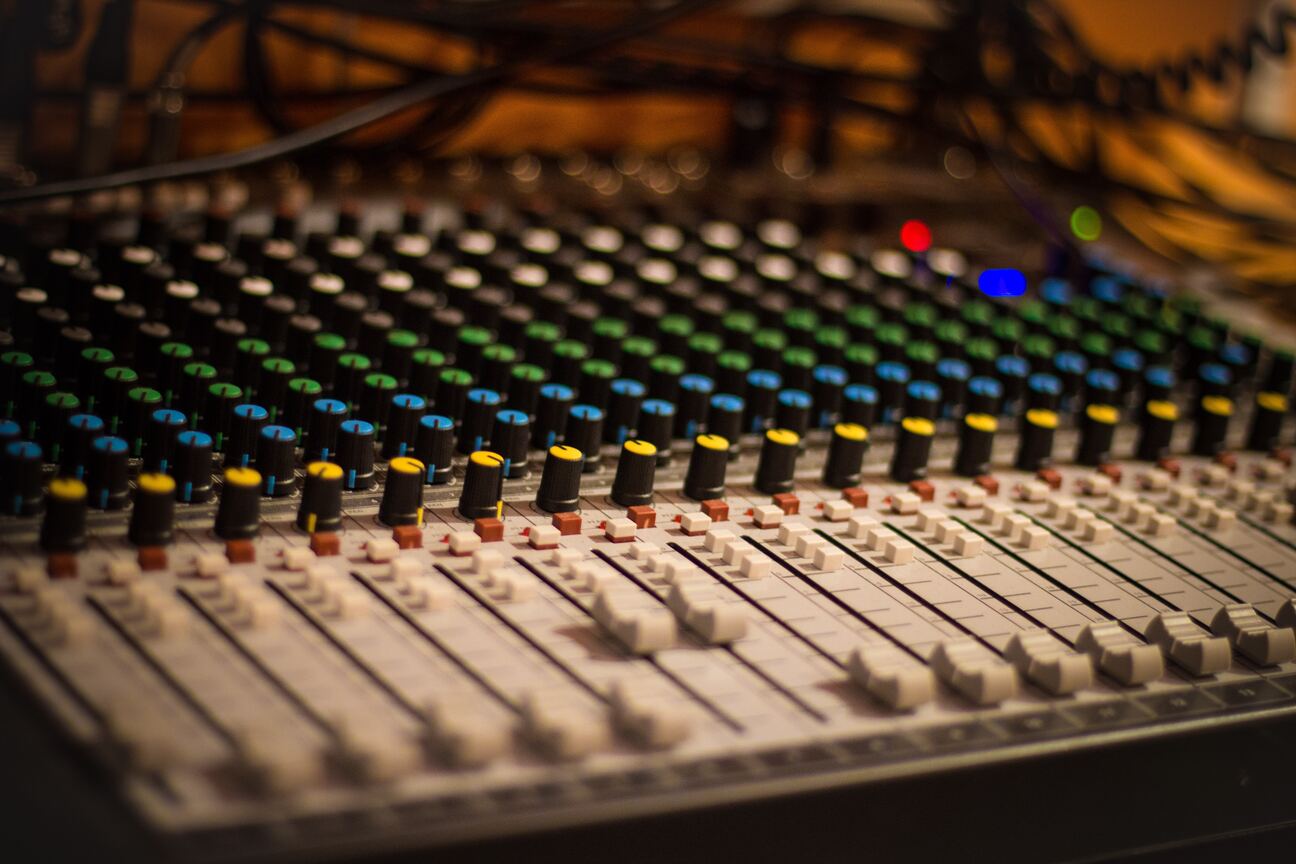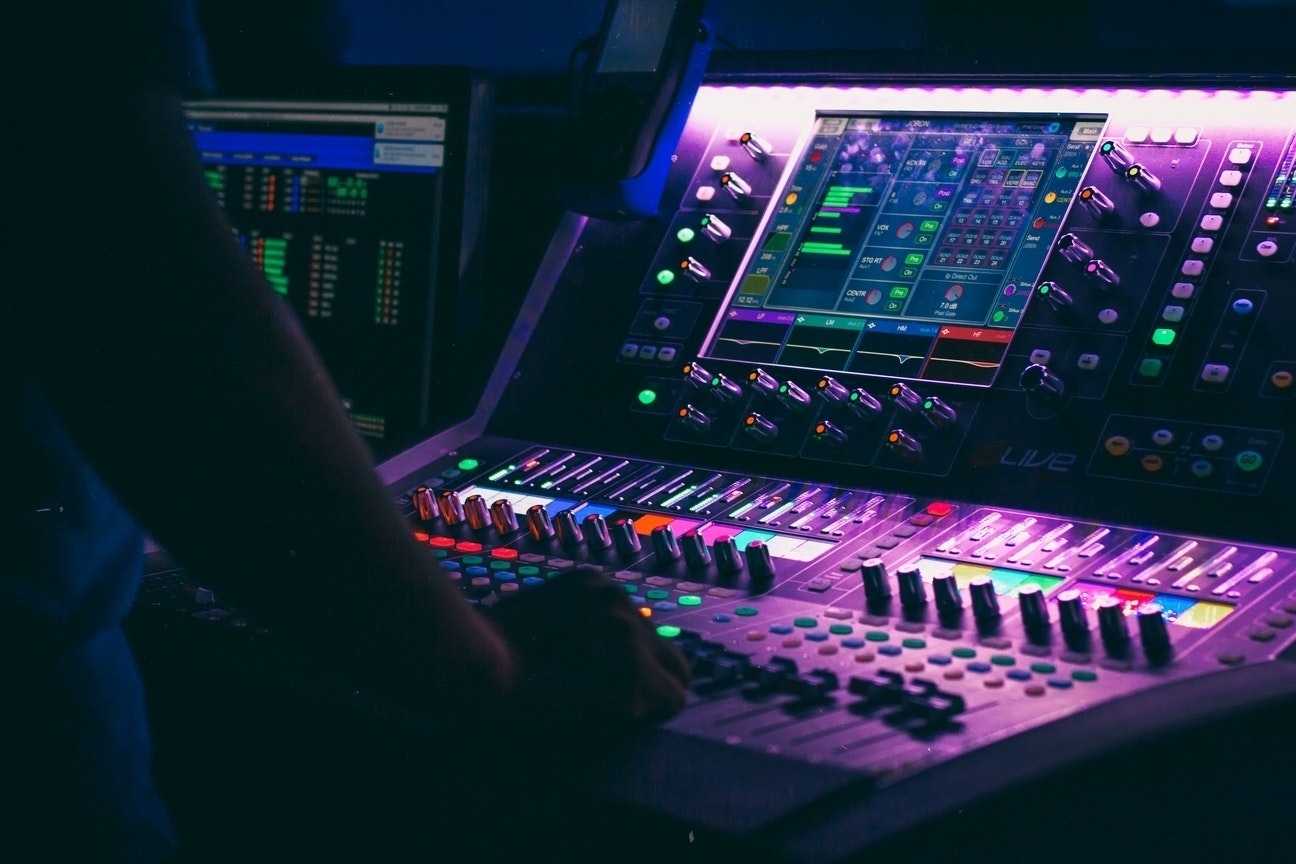
■ Features
Music production is both a creative and technical process. It covers every stage in the making of a track – from its composition to bouncing out the final master.
With so much to learn, getting started can be daunting. You’ll likely have questions about how to make music, which DAW to use and whether to build your own home studio VS using a professional studio. But the truth is - it's never been easier to start producing your own music from your bedroom, armed with nothing but a computer and some creative inspiration. In this guide, we outline everything you need to know to get started with producing your own tracks.
Music production has evolved considerably over the last several decades. To get a better understanding of today’s processes, let’s recap some of the most important events in music production history.
The earliest forms of music production can be traced back to the late 19th century, when sound was first recorded and reproduced using mechanical means. In 1877, Thomas Edison invented the phonograph – the first machine capable of recording and replaying sound. This mechanism allowed music to be distributed on a large scale for the first time.
Fast-forward to the mid-20th century and we see the use of magnetic tape: an invention that made it possible for producers not only to record sound, but to manipulate it too - by physically cutting, adding and looping sounds - giving them more control over the finished product. And in the 1950’s, the emergence of the multitrack recorder allowed instruments and/or voices to be recorded separately and layered to bolster the overall sound.
With innovation in live electronics in the 60’s and 70’s, synthesizers and drum machines found their way into the music producer’s studio and had a huge influence on popular music. The introduction of MIDI (Musical Instrument Digital Interface) in the 80’s allowed producers to control electronic instruments with their computers, paving the way for the modern music production studio as we know it today.
Thanks to the rise of digital technology, today’s budding producers can simply download a DAW (Digital Audio Workstation) to their computer and get started with producing and distributing their own music. Rapidly developing technologies such as AI are also starting to make their mark on the music industry, and may have a considerable impact on the way we produce music in the future.
First and foremost, it’s important to understand that different types of music producers exist in today’s landscape, and their responsibilities can vary depending on the genre they specialise in.
For instance, an electronic musician might consider themselves to be both the artist and the producer - composing, producing, and engineering (i.e. mixing and mastering) their tracks largely by themselves on their computer.
However, a more ‘traditional’ producer might oversee a recording project, acting as a sort of artistic project manager while offering their creative and technical input. They might engineer the project themselves, or they could collaborate with a recording engineer.
Today’s producers often wear multiple hats. But generally, responsibilities can include: budgeting for the project; scheduling recording sessions; gathering creative ideas; composing; supervising the artists; managing or supervising the recording; and mixing/mastering of the tracks.
Producers can add their own sense of style to a recording, and by listening to the work of acclaimed producers like Mark Ronson (Amy Winehouse, Adele, Lady Gaga) and George Martin (The Beatles), you can start to identify their signature techniques and creative choices.
Bearing in mind the responsibilities of a music producer, the following skills and traits will set you up for success:
Leadership & Project Management - As the manager of the recording project, the other artists and engineers will look to you to lead the way.
Organisation - You might be responsible for diary management, booking recording sessions and booking any session musicians.
Music theory & composition - This isn’t necessarily essential – but it will help you to better communicate your musical ideas.
Ability to play an instrument(s) - As above – this is not essential but will enhance your ability to communicate your creative ideas with other musicians.
Recording & engineering - Key if you are mixing and mastering the project yourself, but also important if you are collaborating with an engineer and want to understand their technical processes.
Knowledge of different music genres - This will equip you with inspiration and enable you to borrow creative ideas from different styles of music.
Budgeting - You may need to pay for studio time, musician’s fees, mixing & mastering services, recording software etc. It’s important know how you’re going to cover the costs of producing the recording.
Good communication & people skills - The best producers are patient and excellent at working with other people. You’ll likely be collaborating with other artists, managers, engineers, and label heads – so good communication is an essential skill.
Working as a music producer can be a fulfilling, exciting career - but it is not without its challenges.
The role requires a diverse skillset, and it can take many years to build your experience and establish yourself in the industry. Many music producers work on a freelance basis and are expected to work long, unsociable hours outside of the traditional 9 to 5 schedule.
However, there is a greater variety of potential opportunities in the world of music production than you might think – and there are a multitude of career paths to consider.
Alongside the traditional artist career path, there are many opportunities to make a living in music production.
You could find work as a sound designer in the games industry or as a radio producer for a major broadcaster. You could go into academia and teach university students on a music production course. You could even earn royalties from a remix you made. As a freelancer, you might have the flexibility to do a combination of these jobs.
Average salaries can vary depending on experience, but here’s an idea of what you can expect to earn:

Your computer will be the engine of your music studio – so you’ll want to invest in one that’s capable of running modern software applications and is powerful enough to keep up with your production sessions.
The Apple iMac or Macbook Pro are both popular choices for many producers.
A Digital Audio Workstation (DAW) is a software application used for recording, editing, programming, mixing and mastering audio files.
There are many different DAW’s to choose from, which can be overwhelming for a beginner, but they all serve the same purpose – so find one that suits your workflow and stick to it.
Popular choices for beginners include Logic Pro (Apple), Ableton Live, FL Studio, Cubase and Reaper.
As we touched on earlier, MIDI stands for Musical Instrument Digital Interface. A MIDI Controller is a device that allows users to communicate with their DAW using a physical piece of hardware.
So, instead of fiddling with your computer mouse to drag mixing faders up and down or program beats in – MIDI controllers allow you to produce music in a more intuitive, natural way.
The most popular MIDI controllers look and feel like piano keyboards – but if you’re not familiar with the piano, you can also find MIDI beat pads (such as the Novation Launchpad) and even MIDI guitars.
If you’re planning on recording non-MIDI instruments or voices, you’re going to need an audio interface.
Also referred to as a ‘soundcard’, an audio interface is an important piece of hardware that essentially converts microphone and instrument signals into a format your computer recognises. You plug your guitar or microphone into the interface and send an analog signal – the interface then converts this signal into a digital format, which the computer understands.
There’s a wide range of audio interfaces on the market - all designed to suit different needs. Generally, the price increases with the more input channels an interface has, but there are some great, affordable two-channel interfaces such as the Scarlett 2i2 by Focusrite.
That brings us on to microphones. If you’re going to be recording external sounds, you’ll need a decent microphone to capture them.
When you start on your production journey, there are two types of microphone you should know about: Condenser and Dynamic.
Condenser microphones are typically used for studio recordings: they tend to be more sensitive and therefore more expensive, but they are well suited for capturing delicate sounds and higher frequencies in a studio setting. They also use ‘phantom power’, which can usually be turned on via a switch on your audio interface. The Rode NT1-A is a great affordable option for beginners.
Dynamic microphones, on the other hand, are better suited to live settings and capturing bold, loud sounds such as a drum kit or live vocalist. Dynamic microphones don’t require phantom power – they also tend to be far more robust than their Condenser cousins. The Shure FM58 is known for its versatility and remains to be an industry favourite.
The power of a good set of professional studio headphones should not be underestimated. As a beginner, you’ll likely start off mixing in your headphones. Investing in a professional pair will give you an accurate portrayal of how your mix actually sounds, whereas consumer headphones will often boost bass frequencies and distort the dynamics, deceiving your ears.
Professional studio headphones can range in price dramatically, but some of the most reputable brands include Beyerdynamic, Sennheiser and AudioTechnica. Beyerdynamic’s DT100’s are a trusted industry standard.
If you’re ready to upgrade from mixing on headphones (or you already have the budget for them), a good set of professional. monitors will also help you hear your mix in intricate detail. As with headphones, prices do vary but there are different brands suited to every budget. The famous KRK Rokit’s are a staple in many beginner producer’s studios and are known for representing bass frequencies. The Yamaha HS5’s provide more of a flat response and are also a solid choice.
Room acoustics are often overlooked, but they play a crucial part in both your playing and listening environment.
The environment you’re in has a direct impact on the way something sounds. If you’re in bedroom with lots of furniture and clutter, sounds will bounce off these surfaces and reflect back to you with the ‘colour’ of the room added. It’s the same reason why you sound different when you sing in the shower – bathroom tiles don’t absorb sound and so your voice sounds more resonant and powerful when it’s reflected back at you, along with a touch of natural reverb.
Luckily, you can ‘treat’ your room with some acoustic panelling to tame, absorb and diffuse the reflections. Foam panels are good for absorption and are relatively inexpensive.
Once you’ve got the gear, it’s time to get everything set up. You’ll need a sturdy desk and a comfortable, ergonomic chair to protect your spine while you’re sat down producing for long periods.
It's also good practice to keep a tidy wiring system and arrange your cables neatly to eliminate potential trip hazards. There are plenty of video tutorials on YouTube that walk you through setting up your first home studio – so check out those for some tips and tricks.
It’s absolutely possible to start producing music at home. Many successful producers started off with a humble bedroom studio setup consisting of just a laptop and a DAW.
As you progress and your projects get bigger, you can always upgrade to a larger space or hire a professional recording studio.

In this section, we’ll briefly outline the stages of the music production process - including pre-production, production and post-production.
The pre-production stage covers the creative process that usually comes before the recording stage. This includes the composition and actual writing of the song, and the arrangement (or structure) of the song.
Some producers write their own songs, while others work with artists or singer/songwriters during this process. If you’re not sure how to write a song – you might consider collaborating with other artists.
The production stage covers the actual recording of the song, as well as any audio editing, arranging, sound design and sampling you might do.
While some purist producers work solely with live instruments and vocalists, others use loops and samples. If you are going to sample a song and distribute it, you should be mindful of copyright infringement and what’s considered ‘fair use’ to avoid any legal trouble further down the line. To be safe, you can find royalty-free sample packs and loops on websites like Splice and Loopmasters.
Post-production covers the final mixdown and mastering of your song. Some producers prefer to take the ‘mix as you go’ approach to save time, while others leave their mixing for this final stage.
Mixing includes balancing volume levels, panning, compressing, using EQ to add/remove frequencies and applying any creative effects such as reverb and delay. Our guide to how to mix music covers this process in greater detail.
Mastering is usually the final step in the music production process and essentially polishes the song so that it sounds louder and fuller, in line with professional industry standards. Mastering is an entire job role in itself and take years to get right – so if you don’t have a clear grasp on how to master a song, it’s a good idea to collaborate with a mastering engineer or use a professional online mastering service.
If you’re looking to get started with music production today, many DAW’s offer a free trial so you can test out which one suits your workflow.
Garageband is a great entry-level DAW that comes free with every Mac and is also based on Logic Pro (a popular choice for beginners and professionals alike).
Ableton currently offers a 90-day free trial of their Live 11 Suite: a fantastic DAW for both Windows and Mac users.
🎧 If you’re still stuck, we’ve done a deeper dive into choosing the best DAW for you.
Thanks to the democratisation of technology and the advent of the internet, it’s clear that a career in music production is closer in reach than ever before.
We hope this whistle-stop tour has equipped you with the knowledge you need to get started on your journey as a music producer. Keep listening critically to the work of producers you admire, keep practicing your production skills and put your work out there to be heard!
